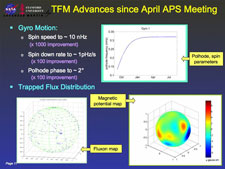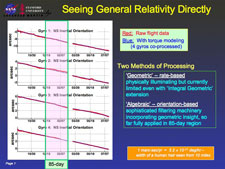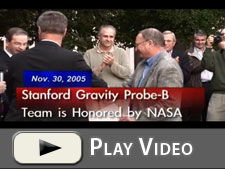MISSION UPDATE — Spring 2008
PROGRAM STATUS
Following is a summary of the status of the GP-B program and the progress we have made since our previous update, posted early in December 2007.
GP-B Program Extended Through September 2008, and Possibly March 2010
On November 2, 2007, we convened the 17th meeting of our external Science Advisory Committee (SAC) to review our progress in the refinement of the GP-B experimental results. The subsequent SAC report noted "the truly extraordinary progress that had been made in data analysis since SAC-16 [March 23-24, 2007]" and unanimously concluded "that GP-B is on an accelerating path toward reaching good science results."
Following a peer-reviewed bridging proposal to NASA's Science Mission Directorate (SMD) and actions by Stanford and a private donor, the GP-B program has been extended at least through September 2008. Furthermore, SMD opened the opportunity for GP-B to submit a proposal this month to its Senior Review process. This is a bi-annual event in which ongoing NASA science programs undergo a peer-review to determine which of those programs NASA should continue and/or extend in order to achieve the greatest scientific gain. Assuming a successful Senior Review, GP-B will be extended one final time, from October 2008 through March 2010.
Increasing the Precision of the Results
From the outset, almost half a century ago, the goal of the GP-B experiment has been to make the most precise and accurate experimental measurement possible of the geodetic and frame-dragging gravitational effects predicted by Einstein's theory. With GP-B, the precision of the result improves as a function of the square root of the length of the data interval time cubed (t3/2). Theoretically, the best case would be one single, uninterrupted year-long data interval, and the precision resulting from such a single interval would be limited only by the sensitivity of the measuring instrument and its inherent noise level. For the frame-dragging effect, this would result in a precision of less than 1% and for the geodetic effect less than 0.01%.
In reality, GP-B experienced six major or significant anomalies during the 353-day science data collection period, and these anomalies caused the experimental data set to be divided into seven major segments, with a total of 307 days of "good" science data when all seven segments are combined. This segmentation reduced the best precision obtainable from the 1% goal down to about 2% for the frame-dragging effect and 0.02% for the geodetic effect. This reduced level of precision, if achieved would be extraordinary.
Reaching this percision has been complicated by two unexpected effects in the data, as we reported in our announcement of first results at the American Physical Society meeting in April 2007:
- A time variation in the polhode motion of the gyroscopes, which creates complications in the gyro scale factor calibrations (conversion of electrical signals to angles).
- Much larger than expected classical misalignment torques on the gyroscopes, attributable to “patch effect” (contact potential difference) interactions between the gyro rotors and their housings.
We have described and discussed these two effects in our past three status updates. After 2 ½ years of data analysis, we have a very good understanding of the physics underlying them. We now know that the interaction of patch effects between the gyro rotors and their housings is the root cause of both, and in our September 25, 2007 status update, we described how our team has honed and utilized a technique called trapped flux mapping to dramatically improve our determinations of the polhode phase and angle for each gyroscope throughout the entire 353-day experiment period.
By necessity, our work to understand and model these two interrelated effects began with very small data segments. For example, the initial analysis was carried out using selected sets of 5-day (75-orbit) segments. Working at this “microscopic” level, the team was ultimately able to model the polhode damping and classical torques. However, stringing together a series of some 60 5-day segments to cover the whole experimental period is not the optimum method of processing the results. Rather, it is necessary to stretch the analysis segments to the point where the only breaks remaining in the data segments are those due to the six anomalies.
In December, we reported that we had successfully applied our much enhanced knowledge and modelling of the polhode phase and angle of each gyroscope to a central 85-day stretch of data, from December 12, 2004 through March 4, 2005. Since that time, we have been in the process of continuing to stretch the data analysis to increasingly long time intervals, so that the final analysis will be based on the seven segments defined by the anomalies experienced on orbit. This will yield the greatest precision possible in the results.
Precision vs Accuracy
In addition to achieving the most precise results possible, it is necessary to ensure that the GP-B results are as accurate as possible. In target practice, if all of your shots cluster consistently at a spot on the outside edge of the target, your shooting would be considered precise, but not accurate. In order to be accurate, you need to hit the bull's eye in the center of the target. It is also possible to be accurate, but not precise. If your shots generally cluster around the bull's eye, but few are actually in the center ring, your shooting would be considered accurate on average, but imprecise due to the large variation or scatter in the locations of the shots.
The goal of GP-B, of course, is to achieve both the most precise and most accurate results possible. In the GP-B experiment, the accuracy of the results is determined by the level of correlation between the four science gyroscopes, which at present is diminished due to the presence of systematic error sources. Until we have reached the physical limits of the experimental apparatus, the more we can identify, model and remove sources of systematic errors from the data for each gyroscope, the greater the correlation between all four of them.
As experimentalists, we make no a priori assumptions that Einstein's predictions represent the bull's eye. Rather, we have collected data, and we are doing everything humanly possible to achieve the greatest precision and accuracy in analyzing it. Once this has been accomplished, we will announce the results. If they match Einstein's predictions, then once again—to the achieved level of precision and accuracy—Einstein's theory will be upheld. If they don't, this could be evidence of a breakdown of the theory.
During this extended data analysis period, we will be working closely with the SAC to review our progress and, if judged necessary, re-focus our analysis efforts. In consultation with the SAC, we may well announce refined interim results to keep the scientific community and the public apprised of our progress. Additionally, a significant portion of this extended data analysis phase will be dedicated to producing scientific and engineering papers, including details of the many exciting technologies of GP-B.
LINKS TO OTHER GP-B TOPICS
- GP-B Frequently Asked Questions (FAQ)
- Track the satellite in the sky
- Build a paper model of the GP-B Spacecraft
- Our mailing list—receive GP-B status updates via email
- View a Flash video of Professor Everitt's 18 May 2006 lecture on GP-B
Note: Both audio-only and video versions of this lecture are also available on the Stanford on iTUNES U Web site. This Web page automatically launches the Apple iTunes program on both Macintosh and Windows computers, with a special Stanford on iTunes U "music store," containing free downloads of Stanford lectures, performances, and events. Francis Everitt's "Testing Einstein in Space" lecture is located in the Science & Technology—Engineering section. People with audio-only iPods can download the version under the Audio tab; people with 5th generation (video) iPods can download the version under the Video tab.
Previous Update | Index of Updates




